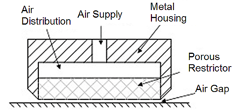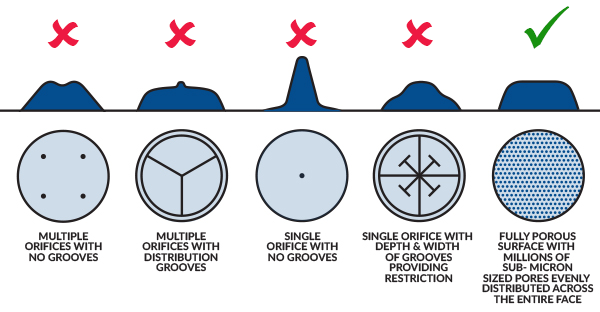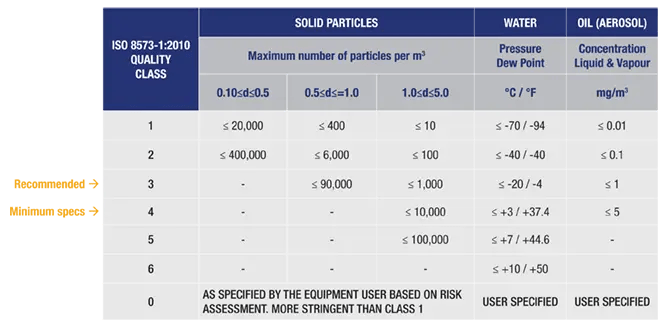- Engineering
- Measuring systems
- Machine qualification
-
Components
-
Systems
-
Learn more
-
- Expertise
-
About IBS
-
Our Story
-
Learn More
-

Learn answers to frequently asked questions about air bearings. Discover unique features and customer benefits and understand how our air bearings can help you when extreme precision is needed in your machine, tool, inspection or transport systems, air bearings are the natural choice.
A bearing in which moving surfaces are kept apart by a layer of air. Air bearings use a thin film of pressurized gas to provide a low friction, load-bearing interface between surfaces. As the two surfaces do not touch, the traditional bearing-related problems of friction, wear, particulates, and lubricant handling can be avoided.

Rolling element bearings developed in the last century were a revolutionary improvement over the plain bearings that had been pushed to their limits in applications like electric motors and automobile wheels. Air bearings can likewise be seen to represent the next logical step in bearing design. These may be exploited by mechanical engineers to extend their design capabilities for precision manufacturing systems.
The use of air bearings in precision systems is well established due to the distinct advantages they offer in precision positioning, such as zero backlash and constant static and dynamic coefficients of friction, so no stick-slip. Thus they have been exploited in applications such as ultra-precision lithography machines and CMMs (Co-ordinate Measuring Machines), semiconductor wafer processing as well as flat panel display transport and inspection. Low friction also means less heat generation, so less thermal disturbance, and minimal power loss for high speed applications, such as high speed precision spindles. While any heat generation is of course not zero, relative surface speeds of the order of 30m/s must be reached before significant heat can be measured when using air bearings.
Air bearings are a natural choice for applications requiring a combination of precision, high speed, repeatable motion and cleanliness. Some of the main concerns a design engineer might raise in design are friction, wear, stiffness and load capacity. Air bearings address these. Zero static friction enables infinite resolution of motion that is highly repeatable. Non-contact motion means virtually zero wear, resulting in consistent machine performance and minimal particulate generation. The air bearing’s fluid film layer averages surface finishing and irregularities on guide surfaces, reducing errors and resulting in straighter motion. Recirculating rollers or balls in rolling element bearings create noise and vibration. Air bearings have no dynamic components resulting in virtually silent operation. Air bearings have a squeeze film damping effect resulting in higher dynamic stiffness and stability.
The typical fly heights for loads on our porous air bearings are of the order of 5 μm, with the exact value chosen according to the stiffness required. For transport and inspection applications where conveyor air bearings are used, such as for Flat Panel Displays or flexible foils, larger fly heights between 20 and 100 μm are normal. As air bearings are loaded, the air gap gets smaller and the pressure in the air film rises—both of which contribute to higher stiffness. Where constant gaps and/or stiffness is required pre-loading can be applied. We provide lift-load curves for all our bearings. For a chosen bearing these specify the fly height of a given load at a given input pressure. The gradient of this curve is the stiffness under the given conditions.
The load capacity for air bearings can vary from 50N to 20kN. Theoretically, the load capacity of an air bearing is simply the input pressure times the surface area. In porous media air bearings the pressure under the bearing is very evenly distributed. However, there is unavoidable leakage of air around the edges of the bearing. As a rule of thumb, the average pressure under the bearing surface is typically 50 percent of the supply pressure. In other words, air bearings are generally about 50 percent efficient. Bearings with more area near their edges, relative to their overall surface area, will be less efficient. Load capacity is determined by the surface area of the bearing, the input pressure, and the bearing’s efficiency.
Load Capacity = Surface Area x Input Pressure x Efficiency
Flat bearings have the highest load capacity. For typical values see our load capacity examples. Custom bearings can carry over 4500kgs each. Vacuum pre-loaded air bearings and stages also support high loads. Air bushings have more limited capacity. However it is possible to series them to increase load capacity.
An appropriate rule of thumb is to size the bearings such that the maximum load the bearing will carry will not result in an air gap less than you are comfortable with (ideally 3 to 5 microns). This value can be determined from our provided lift load curves.
Depending on the application, porous media air bearings may require air at pressures between 2 and 25 bar. 2 bar is typical for conveyor air bearings in transport applications; 4 to 6 bar for flat air bearings or bushings applied in precision applications with loads up to 15000N or more. Up to 25 bar is used for high pressure applications such as rolling road or tyre testing. Because the air flow is restricted by the porous media, the flow is significantly reduced over, for example, orifice bearings.
The flow is indicated for all the air bearings we supply in Normal Litres Per Minute (NLPM) without load. This is the flow at standard conditions of temperature (293.15K) and pressure (1 bar/ 100kPa). Air flow through an air bearing gap is quite sensitive to the size of the gap, following a cubic function with relationship to the size of the gap. As an example, a 5cm diameter bearing with 34 kg of load would consume 1.57 NLPM at 5 microns of lift. For this bearing to carry the same load at 10 microns of lift, 25.18 NLPM. would be required. From this relationship, we can easily see how a smaller gap keeps the restriction high, reducing flow and power requirements.
Yes you can. We supply air bearings made from porous carbon which are applied in cleanrooms up to ISO 5 and above. These cleanrooms are subject to regular particulate testing and show no impact of the air bearings. What is more, the porous media can also act as further filter on pre-filtered air applied.
Yes you can. Both air bushings and rotary tables with air bearings have successfully been applied in vacuum. The gas flow from porous air bearings is inherently low due to the restriction applied by the porous media. This means that differential exhaust schemes with optimally designed parameters to minimize the air leakage into the vacuum chamber can easily be applied.
For over 30 years New Way air bearings have been industry leaders in porous media air bearings. IBS Precision Engineering are world-renowned leaders in their field of ultra-precision measurement, motion and product engineering. Together New Way and IBS have developed unique solutions trusted by industry leaders from semicon to autosport and institutes such as CERN integrating the latest technologies for air bearings. A partnership of over 20 years engineering success.
Gas can be delivered through one of two air bearing types—those with orifices or those made from porous media. In an orifice bearing, pressurized air is supplied through precisely sized holes placed on the bearing surface. These holes are typically combined with grooves to distribute the pressurized air evenly across the bearing face. The drawback of orifice delivery is that air loses pressure and creates pressure gradients in the air gap as it expands away from the orifice or groove. Porous media air bearings allow air to be supplied through the entire surface of the bearing, due to millions of holes in the porous material. Thus it acts as an ideal air bearing supplying air pressure equally across the face of the bearing.

Air Bearing Pressure Profiles
First of all, do not operate air bearing products unless air pressure is applied. The compressed air supply must be free from contaminants and moisture. It is strongly advised to use a filtered air supply, ideally of ISO-class 3, but at the very least ISO-class 4.
See ISO-table below for specifications.
